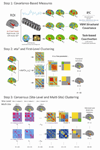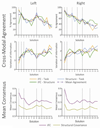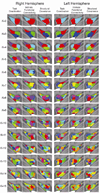A convergent functional architecture of the insula emerges across imaging modalities
- PMID: 22440648
- PMCID: PMC3376229
- DOI: 10.1016/j.neuroimage.2012.03.021
A convergent functional architecture of the insula emerges across imaging modalities
Abstract
Empirical evidence increasingly supports the hypothesis that patterns of intrinsic functional connectivity (iFC) are sculpted by a history of evoked coactivation within distinct neuronal networks. This, together with evidence of strong correspondence among the networks defined by iFC and those delineated using a variety of other neuroimaging techniques, suggests a fundamental brain architecture detectable across multiple functional and structural imaging modalities. Here, we leverage this insight to examine the functional organization of the human insula. We parcellated the insula on the basis of three distinct neuroimaging modalities - task-evoked coactivation, intrinsic (i.e., task-independent) functional connectivity, and gray matter structural covariance. Clustering of these three different covariance-based measures revealed a convergent elemental organization of the insula that likely reflects a fundamental brain architecture governing both brain structure and function at multiple spatial scales. While not constrained to be hierarchical, our parcellation revealed a pseudo-hierarchical, multiscale organization that was consistent with previous clustering and meta-analytic studies of the insula. Finally, meta-analytic examination of the cognitive and behavioral domains associated with each of the insular clusters obtained elucidated the broad functional dissociations likely underlying the topography observed. To facilitate future investigations of insula function across healthy and pathological states, the insular parcels have been made freely available for download via http://fcon_1000.projects.nitrc.org, along with the analytic scripts used to perform the parcellations.
Copyright © 2012 Elsevier Inc. All rights reserved.
Figures





References
-
- Ackermann H, Riecker A. The contribution(s) of the insula to speech production: a review of the clinical and functional imaging literature. Brain Struct Funct. 2010;214:419–433. - PubMed
-
- Adolphs R, Tranel D, Damasio AR. Dissociable neural systems for recognizing emotions. Brain Cogn. 2003;52:61–69. - PubMed
-
- Augustine JR. Circuitry and functional aspects of the insular lobe in primates including humans. Brain Res Brain Res Rev. 1996;22:229–244. - PubMed
-
- Bellec P, Rosa-Neto P, Lyttelton OC, Benali H, Evans AC. Multi-level bootstrap analysis of stable clusters in resting-state fMRI. Neuroimage. 2010;51:1126–1139. - PubMed
Publication types
MeSH terms
Grants and funding
- R01 DA016979/DA/NIDA NIH HHS/United States
- R01DA016979/DA/NIDA NIH HHS/United States
- K23MH087770/MH/NIMH NIH HHS/United States
- R01 MH081218/MH/NIMH NIH HHS/United States
- R01HD065282/HD/NICHD NIH HHS/United States
- R01 HD065282/HD/NICHD NIH HHS/United States
- 2T32DA007254-16A2/DA/NIDA NIH HHS/United States
- R01MH081218/MH/NIMH NIH HHS/United States
- R01MH083246/MH/NIMH NIH HHS/United States
- T32 DA007254/DA/NIDA NIH HHS/United States
- K23 MH087770/MH/NIMH NIH HHS/United States
- R03 DA024775/DA/NIDA NIH HHS/United States
- R01 MH083246/MH/NIMH NIH HHS/United States
- R03DA024775/DA/NIDA NIH HHS/United States
LinkOut - more resources
Full Text Sources
Medical
Molecular Biology Databases

